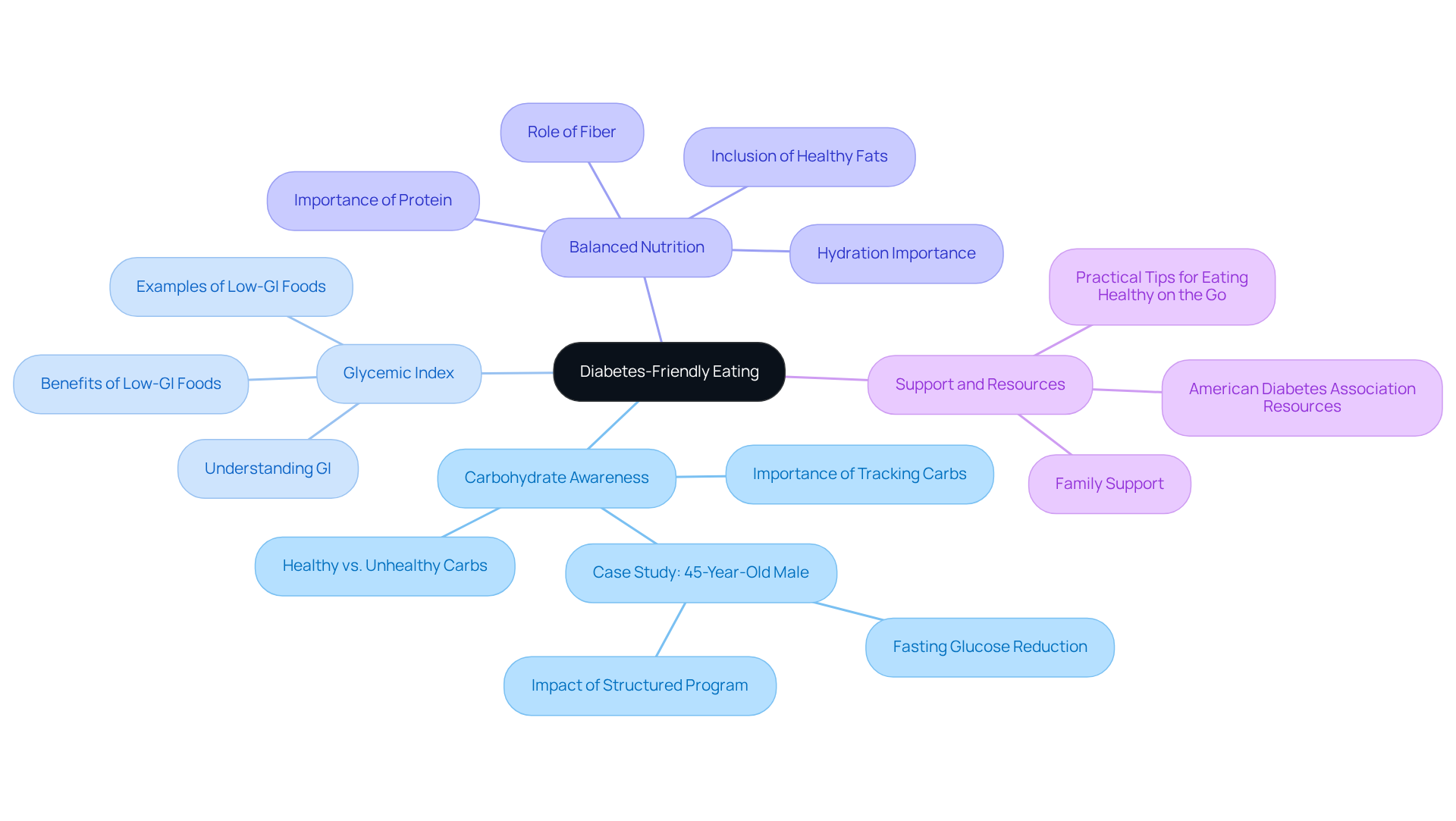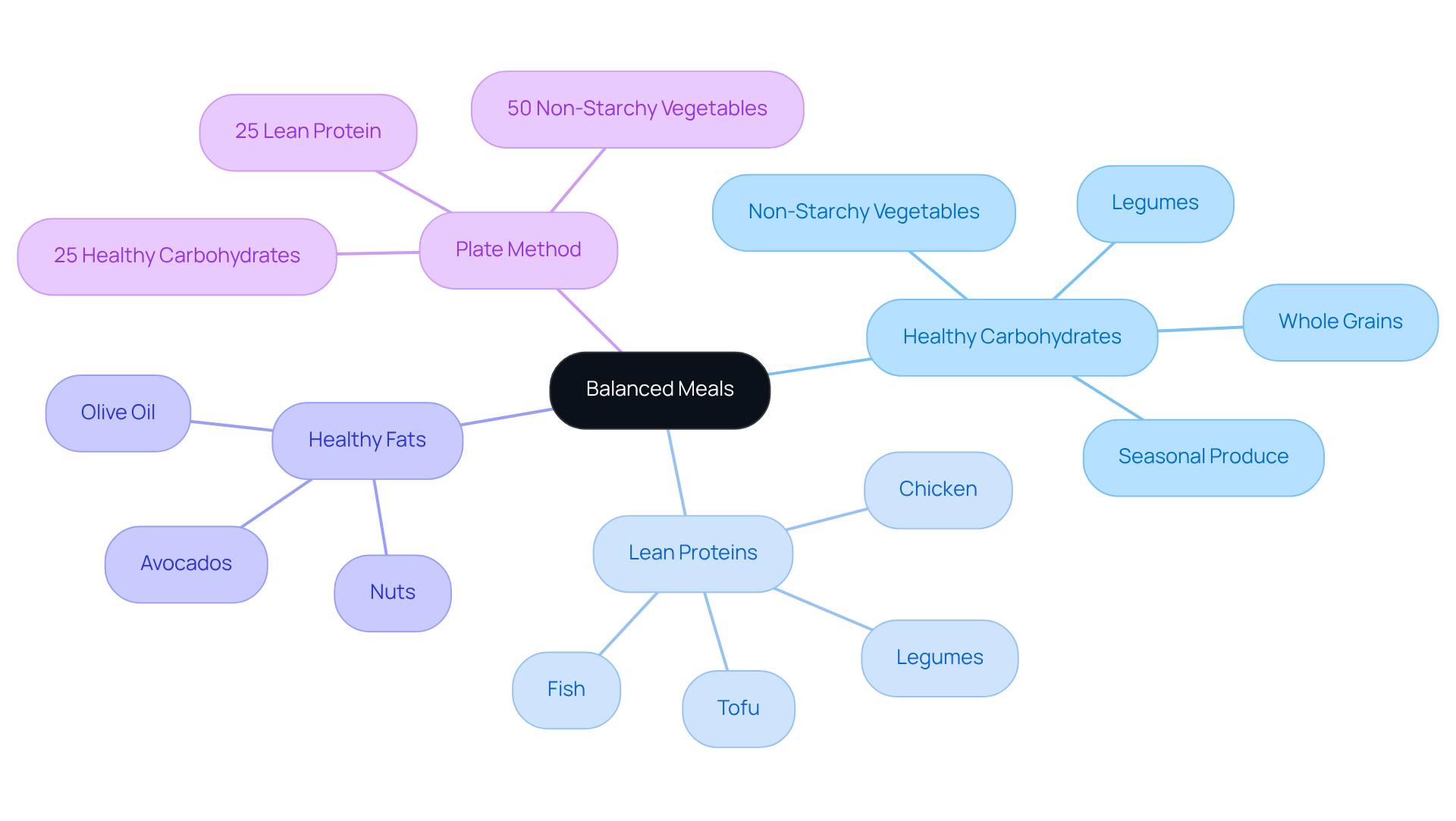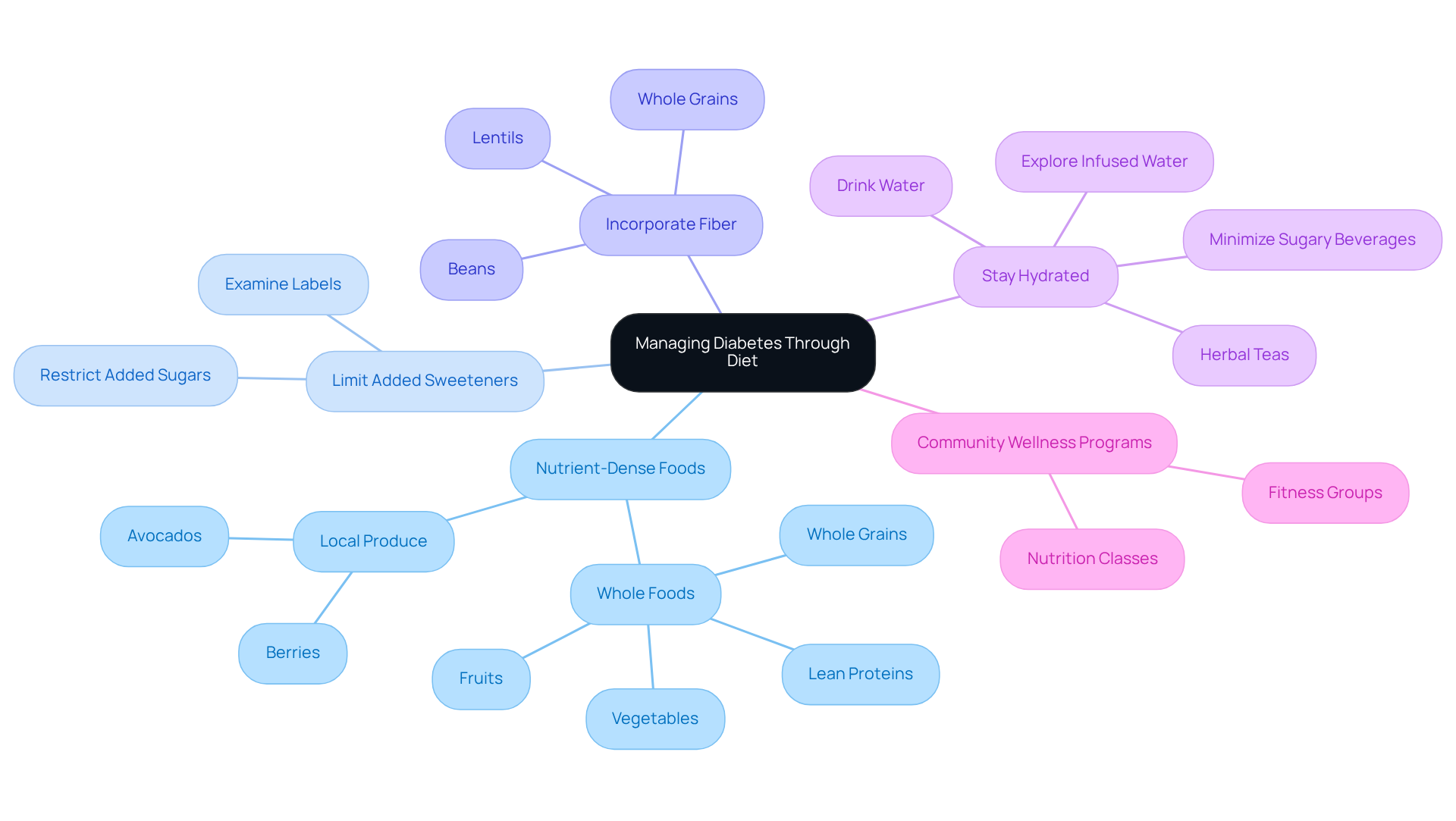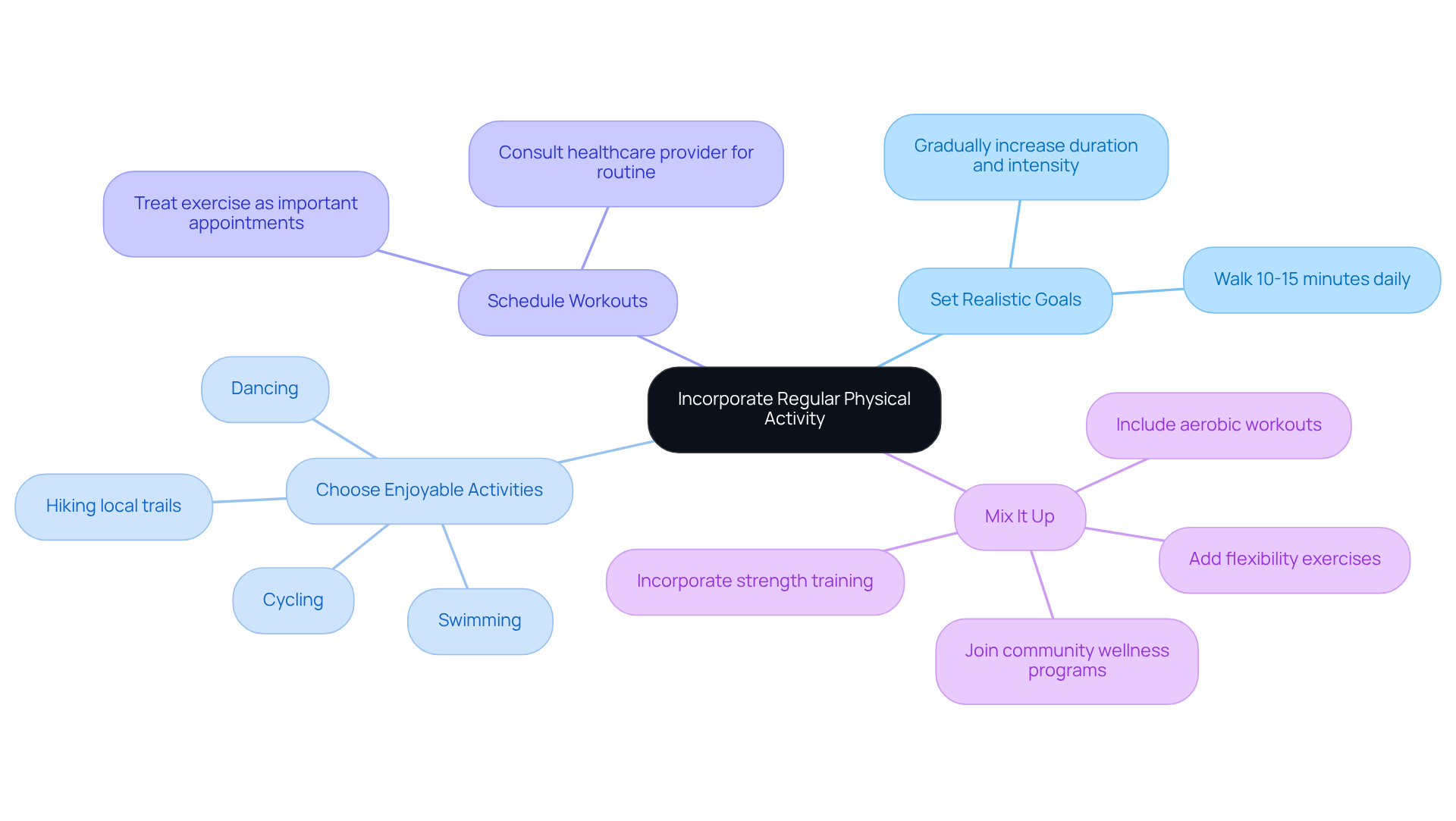Overview
Managing Type 2 diabetes can feel overwhelming, but there are five essential steps that can guide you toward a healthier lifestyle.
- Understanding carbohydrate intake is crucial; it’s important to recognize that not all carbs are created equal. Many patients find that utilizing the glycemic index helps them make informed choices about the foods they eat.
- Planning balanced meals with healthy foods is another vital step. By focusing on whole, nutritious options, you can support your body’s needs while enjoying your meals.
- Monitoring portion sizes is also key to maintaining control over your blood sugar levels. This might seem challenging, but small adjustments can lead to significant improvements.
- Incorporating regular physical activity is essential. Not only does it help manage your diabetes, but it also boosts your overall well-being.
- Remember, you’re not alone on this journey; evidence and community resources are here to empower you every step of the way. Embrace these steps as part of your 30-Day Diabetes Reset program, and take charge of your health with confidence.
Introduction
Managing diabetes type 2 can feel overwhelming, can’t it? It requires more than just medication; it calls for a thoughtful approach to nutrition that can significantly impact your health. Understanding the principles of diabetes-friendly eating empowers you to make informed choices that stabilize blood sugar levels and enhance your overall well-being. However, with so much conflicting information available, how can you navigate the complexities of meal planning and dietary restrictions effectively?
It’s important to recognize that you are not alone in this journey. Many individuals face similar struggles, and finding the right path can be challenging. This article outlines five essential steps for eating effectively with diabetes type 2, offering practical strategies that can transform your dietary habits and support a healthier lifestyle. Together, we can explore these steps and work towards a brighter, healthier future.
Understand the Basics of Diabetes-Friendly Eating
Eating for diabetes type 2 involves understanding how different foods impact your glucose levels. It’s important to recognize that managing diabetes can be challenging, but by focusing on a few key principles, you can take steps toward better health.
-
Carbohydrate Awareness: Carbohydrates play a significant role in blood sugar levels. Distinguishing between healthy and unhealthy options is essential. Many nutritionists emphasize the importance of tracking carbohydrate intake for effective diabetes management. For instance, one case study highlighted a 45-year-old man with unmanaged diabetes. By following a structured program focused on eating for diabetes type 2 and carbohydrate control, he saw his fasting glucose levels decrease from 293 mg/dL to 134 mg/dL. This shows just how impactful eating for diabetes type 2 can be.
-
Glycemic Index: Familiarizing yourself with the glycemic index (GI) is vital. This index ranks foods based on their effect on glucose levels, with low-GI foods being preferable since they lead to a gradual rise in blood sugar. Many patients find that understanding the GI helps them make informed dietary choices that promote stable glucose levels.
-
Balanced Nutrition: A balanced diet is crucial for managing diabetes effectively. Including healthy fats, proteins, and fiber alongside carbohydrates can help stabilize glucose levels. This comprehensive approach not only aids in glucose regulation but also enhances your overall well-being.
By embracing these essential concepts, you can make informed food selections that support your health journey and empower you in the process of eating for diabetes type 2 effectively. Remember, you are not alone in this journey, and with the right knowledge and support, you can thrive.
Plan Balanced Meals with Healthy Carbohydrates and Proteins
Creating balanced meals can feel overwhelming at times, but with a little guidance, it becomes an empowering journey toward better health.
-
Choose Healthy Carbohydrates: It’s important to recognize that opting for whole grains, legumes, and non-starchy vegetables can significantly benefit your well-being. These choices provide essential fiber and nutrients without causing rapid spikes in blood sugar. Many find joy in incorporating seasonal produce from local farmers’ markets, like avocados and leafy greens, which not only enhance meals but also contribute to eating for diabetes type 2.
-
Incorporate Lean Proteins: Many patients discover that including sources of lean protein such as chicken, fish, tofu, or legumes helps them feel fuller longer. Protein can also slow the absorption of carbohydrates, making it a vital part of your meals. There are numerous nearby eateries in San Marcos that highlight lean proteins, simplifying your journey toward a nutritious diet.
-
Add Healthy Fats: You might be surprised to learn that incorporating healthy fats from sources like avocados, nuts, and olive oil can enhance your meals. These fats not only promote satiety but also provide essential nutrients. By highlighting local ingredients, you not only nourish your body but also connect with your community.
-
Use the Plate Method: Visualizing your plate can make meal planning easier. Many find that dividing their plate into sections—half for non-starchy vegetables, a quarter for lean protein, and a quarter for healthy carbohydrates—helps create balance. Community wellness programs are available to support you in implementing these strategies effectively.
By embracing these steps and engaging with the local way of life in San Marcos, you can craft meals that support eating for diabetes type 2 while enhancing your well-being and helping to maintain steady glucose levels. For personalized guidance, consider attending events hosted by Dr. Jason Shumard, where you can learn more about effective diabetes management. Remember, you’re not alone on this journey; there are resources and support available to help you thrive.
Choose Nutrient-Dense Foods and Limit Sugars
When selecting foods, it’s essential to focus on nutrient-dense options that support overall health and are important for eating for diabetes type 2 while helping to manage blood sugar levels.
-
Prioritize Whole Foods: It’s important to emphasize whole, unprocessed foods like fruits, vegetables, whole grains, and lean proteins. In San Marcos, local farmers’ markets offer a rich variety of fresh produce, including seasonal fruits such as avocados and berries, which are perfect for a diabetes-friendly diet. These items are abundant in vital vitamins, minerals, and fiber, all crucial for maintaining stable glucose levels.
-
Limit Added Sweeteners: Be mindful of added sweeteners lurking in processed foods. Examining labels is key; aim to limit your intake of sweeteners, as excessive consumption can lead to spikes in glucose levels. Many patients find that restricting added sugars is essential for effective metabolic management, as they can significantly impact glycemic regulation.
-
Incorporate Fiber-Rich Items: Including foods high in fiber, such as beans, lentils, and whole grains, can be very beneficial. These foods are essential for eating for diabetes type 2, as they help manage glucose levels and promote digestive health. The local cuisine in San Marcos often features dishes rich in fiber, which can support your dietary needs beautifully.
-
Stay Hydrated: Ensuring adequate hydration is vital. Drink plenty of water and minimize sugary beverages. Staying hydrated is crucial for overall well-being and can help control hunger, reducing the urge to reach for high-sugar snacks. Consider exploring local options like infused water or herbal teas to stay refreshed without affecting your blood sugar levels.
-
Engage with Community Wellness Programs: Participating in local wellness programs can provide valuable support and resources for managing diabetes. Look for classes or groups focused on nutrition and fitness that can help you stay motivated and informed.
By making these informed dietary choices and engaging with community resources, you can significantly enhance the nutritional quality of your meals while effectively focusing on eating for diabetes type 2. Remember, the success stories of individuals who have transformed their health through personalized programs highlight the importance of community support and tailored guidance in your journey to manage diabetes.
Monitor Portion Sizes and Read Food Labels Carefully
Managing portion sizes can feel challenging, but you’re not alone on this journey. It’s important to recognize that small changes can make a big difference in your overall well-being.
-
Utilize Measuring Instruments: Have you considered investing in measuring cups and a scale? These tools can help you accurately gauge portion sizes, especially when you’re just starting out. They can be your allies in achieving your health goals.
-
Practice Mindful Eating: Many patients find that paying attention to hunger cues and eating slowly can transform their eating experience. This practice not only helps prevent overeating but also promotes better digestion, allowing you to enjoy your meals more fully.
-
Read Nutrition Labels: Getting to know nutrition labels is crucial. Understanding serving sizes, carbohydrate content, and nutritional information can empower you to make healthier choices. Look for products that are lower in sweetness and higher in fiber; these options can be more satisfying and beneficial for your health.
-
Portion Control Plates: Have you thought about using portion control plates? These can visually guide you in serving appropriate amounts of food, making it easier to manage your intake.
By implementing these strategies, you can take positive steps toward managing your food intake while focusing on eating for diabetes type 2 and maintaining stable blood sugar levels. Remember, every small effort counts, and you’re making progress on your journey to better health.
Incorporate Regular Physical Activity into Your Routine
Incorporating regular physical activity into your routine is essential for managing type 2 diabetes effectively, especially in the vibrant environment of San Marcos, CA. It’s important to recognize that starting this journey can feel overwhelming, but taking small steps can lead to significant changes. Here are some key strategies to help you get started:
-
Set Realistic Goals: Begin with achievable targets, such as walking for 10-15 minutes daily around scenic spots like Lake San Marcos or Discovery Lake. Gradually increase both the duration and intensity of your workouts to build endurance and confidence.
-
Choose Enjoyable Activities: Many patients find that engaging in physical activities they enjoy, whether it’s hiking the local trails, dancing, swimming, or cycling, makes a difference. The beautiful San Marcos weather and outdoor lifestyle provide ample opportunities to find activities you love. When you enjoy what you’re doing, you’re more likely to stick with it, making exercise a sustainable part of your lifestyle.
-
Schedule Workouts: Treat your exercise sessions as important appointments. By scheduling them into your day, you ensure that physical activity becomes a regular and non-negotiable part of your routine. It’s recommended to consult with your healthcare provider when organizing your exercise routine to ensure it matches your wellness requirements.
-
Mix It Up: Consider incorporating a variety of exercises, including strength training, aerobic workouts, and flexibility exercises. This not only maintains your routine’s engagement but also offers extensive wellness advantages, such as enhanced cardiovascular function and improved weight control. Joining community wellness programs that focus on fitness and diabetes education can provide additional support.
Consistent physical exercise can lead to reduced blood glucose, blood pressure, and cholesterol levels, aiding in improved long-term well-being. By incorporating physical activity regularly into your life, you can greatly boost your overall well-being and enhance your capacity to manage diabetes. Remember, starting with small, manageable changes can lead to significant improvements in your health and well-being.
Conclusion
Eating for diabetes type 2 can feel overwhelming, but it encompasses a range of strategies designed to help you manage your blood sugar levels through informed dietary choices. It’s important to recognize how different foods—especially carbohydrates—affect your health. By focusing on balanced nutrition, you can take significant steps toward feeling better. Many patients find that understanding the glycemic index and choosing nutrient-dense foods makes a real difference. Engaging in mindful eating and incorporating regular physical activity can also support your journey.
Key insights from this article emphasize the importance of:
- Selecting healthy carbohydrates
- Adding lean proteins
- Including healthy fats in your meals
Have you tried portion control techniques or learned to read food labels? These practices can empower you to make healthier choices. Remember, the role of community support and local resources can enhance your experience in managing diabetes, making it feel like a shared journey rather than a solitary one.
Ultimately, the path to effectively eating for diabetes type 2 is about empowerment and informed decision-making. By embracing these principles and utilizing available resources, you can significantly improve your quality of life. Engaging with local wellness programs, exploring fresh produce at farmers’ markets, and incorporating enjoyable physical activities can further enhance this journey. The commitment to understanding and implementing these strategies not only promotes better health but also fosters a supportive community for those navigating the challenges of diabetes. Together, we can make this journey a positive one.
Frequently Asked Questions
What is the importance of carbohydrate awareness in diabetes management?
Carbohydrate awareness is crucial as carbohydrates significantly impact blood sugar levels. Tracking carbohydrate intake helps in managing diabetes effectively, as demonstrated by a case study where a man’s fasting glucose levels improved by focusing on carbohydrate control.
How does the glycemic index (GI) influence food choices for diabetes?
The glycemic index ranks foods based on their effect on glucose levels. Low-GI foods are preferable as they cause a gradual rise in blood sugar, aiding individuals in making informed dietary choices that promote stable glucose levels.
What components should be included in a balanced diet for diabetes management?
A balanced diet for managing diabetes should include healthy fats, proteins, and fiber alongside carbohydrates. This comprehensive approach helps stabilize glucose levels and enhances overall well-being.
What are some examples of healthy carbohydrates to include in meals?
Healthy carbohydrates include whole grains, legumes, and non-starchy vegetables. These options provide essential fiber and nutrients without causing rapid spikes in blood sugar.
Why is it beneficial to incorporate lean proteins into meals?
Lean proteins such as chicken, fish, tofu, or legumes help individuals feel fuller longer and slow the absorption of carbohydrates, making them a vital part of meals for diabetes management.
How can healthy fats contribute to a diabetes-friendly diet?
Healthy fats from sources like avocados, nuts, and olive oil can enhance meals by promoting satiety and providing essential nutrients, supporting overall health.
What is the Plate Method and how does it assist in meal planning?
The Plate Method involves dividing your plate into sections: half for non-starchy vegetables, a quarter for lean protein, and a quarter for healthy carbohydrates. This visual approach simplifies meal planning and helps create balanced meals.
How can local resources and community support aid in managing diabetes?
Engaging with local resources, such as farmers’ markets for fresh produce and community wellness programs, can provide support and guidance in creating meals that align with diabetes management. Events hosted by professionals like Dr. Jason Shumard can also offer personalized guidance.




